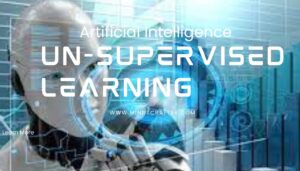
AI Un-supervised Learning
Mastering Unsupervised Learning:
Unsupervised learning is a powerful technique that allows machines to learn from data without explicit guidance or supervision. It’s a crucial tool in the field of artificial intelligence and machine learning, providing insights and information that can be difficult or impossible to uncover through other methods. However, mastering unsupervised learning requires a deep understanding of the techniques and best practices that make it effective. From clustering and dimensionality reduction to anomaly detection and association rule mining, various approaches can be used to unlock the full potential of unsupervised learning. This article will explore some of the key techniques and best practices for mastering unsupervised learning and how they can be applied to real-world problems and challenges. Whether you’re an experienced data scientist or just starting in the field, this article will also help you take your unsupervised learning skills to the next level.
Types of Unsupervised Learning Algorithms:
Unsupervised learning algorithms are designed to identify patterns and relationships in data without the need for direct supervision or guidance. Several types of unsupervised learning algorithms include clustering, dimensionality reduction, anomaly detection, and association rule mining.
# Clustering:
Clustering is a technique used to group similar data points together based on their characteristics and attributes. The algorithm works by partitioning the data into clusters, with each set containing data points that are similar to one another. Clustering can be used for various applications, including image analysis, market segmentation, and outlier detection.
One of the most common clustering algorithms is k-means clustering. This algorithm divides the data into k clusters, each represented by a centroid. The algorithm iteratively moves the centroids until the sets are optimized.
#Dimensionality Reduction:
Dimensionality reduction is a technique used to reduce the number of variables in a dataset without losing important information. This technique is beneficial for datasets with many features, as it can help simplify the data and make it easier to analyze.
One common technique for dimensionality reduction is principal component analysis (PCA). However, this technique works by identifying the most critical variables in a dataset and creating new variables that are linear combinations of the original variables. The new variables, or principal components, can then be used to represent the data in a lower-dimensional space.
#Anomaly Detection:
Anomaly detection is a technique used to identify data points that are significantly different from the rest of the data. This technique is beneficial for identifying outliers, which can indicate errors or anomalies in the data.
One common technique for anomaly detection is the isolation forest algorithm. However, this algorithm works by randomly partitioning the data into smaller subsets and then isolating the anomalies in those subsets. The algorithm then uses the number of partitions required to separate the monsters as a measure of their significance.
#Association Rule Mining:
Association rule mining is a technique used to identify relationships between variables in a dataset. This technique is beneficial for recognizing patterns and trends in transactional data, such as customer purchasing behaviour.
One common technique for association rule mining is the Apriori algorithm. However, this algorithm identifies frequent item sets or groups of items frequently appearing together in the data. The algorithm then uses these standard item sets to generate association rules describing the relationships between the items.
Applications of Unsupervised Learning:
Unsupervised learning can be applied to a wide range of applications and industries. Some of the most common applications of unsupervised learning include:
#image Analysis:
Unsupervised learning can be used to analyze images and identify patterns and features that may be difficult for humans to detect. This technique is beneficial for applications such as object recognition, where the algorithm must identify specific features in an image.
#Market Segmentation:
Unsupervised learning can be used to segment customers into different groups based on their behaviour and preferences. This technique benefits businesses targeting specific customer segments with tailored marketing messages.
#Fraud Detection:
Unsupervised learning can be used to detect fraudulent activity in financial transactions. This technique is beneficial for identifying anomalies and patterns that may be indicative of fraudulent behaviour.
#Recommender Systems:
Unsupervised learning can be used to build recommender systems, which provide personalized recommendations to users based on their behaviour and preferences. This technique benefits e-commerce and media companies, which rely on personalized recommendations to drive sales and engagement.
Advantages and Disadvantages of Unsupervised Learning:
Like all machine learning techniques, unsupervised learning has both advantages and disadvantages.
#Advantages of unsupervised learning:
Unsupervised learning excels in identifying patterns and relationships in data autonomously, without explicit guidance or supervision. This powerful tool uncovers valuable insights and information that might be challenging or unattainable through alternative methods.
Additionally, unsupervised learning effortlessly handles large and complex datasets, making it highly advantageous for image analysis, natural language processing, and other domains where vast amounts of data can be overwhelming.
#Disadvantages of unsupervised learning:
Unsupervised learning has a primary disadvantage: its reliance on assumptions about the data. Without explicit labels or supervision, it becomes challenging to determine the meaningfulness of patterns and relationships identified by the algorithm.
Furthermore, unsupervised learning is prone to overfitting. In the absence of explicit labels or supervision, the algorithm may identify non-existent patterns and relationships in the data.
Best Practices for Unsupervised Learning
To make the most of unsupervised learning, following some best practices and guidelines is essential.
#Ensure Quality Data:
One of the essential best practices for unsupervised learning is to ensure that the data is of high quality and free from errors. Furthermore, To achieve this, one can perform data cleaning and preprocessing, which entails removing duplicates, filling missing values, and standardizing the data.
#Choose the Right Algorithm:
Another critical best practice for unsupervised learning is choosing the correct algorithm for the task. This requires a deep understanding of the strengths and weaknesses of different algorithms, as well as the specific requirements of the application.
#Evaluate Results:
Finally, it’s essential to evaluate the results of the unsupervised learning algorithm to ensure that the patterns and relationships identified are meaningful and valuable. This can be achieved through visualization and statistical analysis, as well as through domain expertise and intuition.
Techniques for Clustering:
Clustering is one of the most common unsupervised learning techniques, and several algorithms can be used to cluster data.
#K-Means Clustering:
K-means clustering is one of the most common clustering algorithms. This algorithm divides the data into k clusters, each represented by a centroid. The algorithm iteratively moves the centroids until the groups are optimized.
K-means clustering is particularly useful for applications such as customer segmentation and image analysis, where the algorithm needs to be able to group similar data points together.
#Hierarchical Clustering:
Hierarchical clustering is another standard clustering algorithm. This algorithm creates a tree-like cluster structure, with each data point initially assigned to its own cluster. The algorithm then iteratively merges sets until all of the data points are in a single cluster.
Hierarchical clustering is particularly useful for applications such as gene expression analysis and market segmentation, where the algorithm needs to be able to identify clusters at different levels of granularity.
#Density-Based Clustering:
Density-based clustering is a clustering algorithm that identifies areas of high density in the data and partitions the data into clusters based on these areas. This algorithm is handy for anomaly detection and image segmentation applications.
One standard density-based clustering algorithm is DBSCAN. This algorithm works by identifying areas of high density in the data and partitioning the data into clusters based on these areas.
Techniques for Dimensionality Reduction:
Dimensionality reduction is a technique used to reduce the number of variables in a dataset without losing important information. Several techniques can be used to perform dimensionality reduction.
#Principal Component Analysis:
Principal component analysis (PCA) is one of the most common techniques for dimensionality reduction. This technique works by identifying the most critical variables in a dataset and creating new variables that are linear combinations of the original variables. The new variables, or principal components, can then be used to represent the data in a lower-dimensional space.
PCA is beneficial for applications such as image analysis and natural language processing, where the amount of data can be overwhelming.
# Singular Value Decomposition:
Singular value decomposition (SVD) is another technique for dimensionality reduction. This technique decomposes the original data matrix into three matrices: a matrix of left singular vectors, a matrix of suitable singular vectors, and a diagonal matrix of singular values.
SVD is particularly useful for applications such as collaborative filtering and image compression, where the algorithm must capture the most critical information in the data.
Techniques for Anomaly Detection:
Anomaly detection is a technique used to identify data points that are significantly different from the rest of the data. Several techniques can be used to perform anomaly detection.
#Isolation Forest Algorithm:
The isolation forest algorithm is a technique for anomaly detection that works by randomly partitioning the data into smaller subsets and then isolating the anomalies in those subsets. The algorithm then uses the number of partitions required to separate the monsters to measure their significance.
The isolation forest algorithm is handy for applications such as fraud detection and outlier detection, where the algorithm must identify unusual patterns or behaviours in the data.
#Local Outlier Factor:
The local outlier factor (LOF) algorithm is another technique for anomaly detection. This algorithm works by identifying data points with a low density of neighbouring points that are likely to be anomalies.
The LOF algorithm is handy for applications such as network intrusion detection and credit card fraud detection, where the algorithm needs to be able to identify unusual patterns or behaviours in the data.
Case Studies of Successful Unsupervised Learning Applications:
Unsupervised learning has been used successfully in various applications and industries. Some of the most notable examples include:
#Google News:
Google News uses unsupervised learning to identify news articles that are related to one another. The algorithm clusters articles based on their content and then presents the most critical essays from each cluster to users.
#Amazon:
Amazon uses unsupervised learning to build its recommendation engine, which provides personalized recommendations to users based on their behaviour and preferences. The algorithm works by analyzing user behaviour and identifying patterns and relationships in the data.
#Ancestry.com:
Ancestry.com uses unsupervised learning to help users trace their family history. The algorithm analyses DNA samples and identifies patterns and relationships in the data.
Future of Unsupervised Learning:
Unsupervised learning is a rapidly evolving field, constantly developing new techniques and algorithms. Some of the most promising areas for future research include:
#Deep Learning:
Deep learning is a subfield of machine learning that uses neural networks to perform complex tasks. Unsupervised learning is an essential component of deep learning and is used to train neural networks to identify patterns and relationships in the data.
#Reinforcement Learning:
Reinforcement learning is a subfield of machine learning that focuses on training agents to make decisions based on rewards and punishments. Unsupervised learning can be used to help the agent identify patterns and relationships in the data, which can then be used to inform its decision-making process.
Conclusion:
Unsupervised learning is a powerful technique that can be used to identify patterns and relationships in data without the need for explicit guidance or supervision. From clustering and dimensionality reduction to anomaly detection and association rule mining, various approaches can be used to unlock the full potential of unsupervised learning. Data scientists and machine learning practitioners can take their unsupervised learning skills to the next level by following best practices and guidelines and staying up-to-date on the latest techniques and algorithms.
